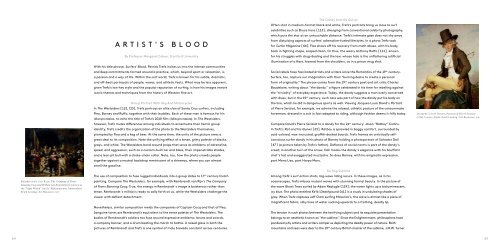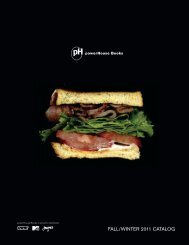This PDF is NOT the entire book - powerHouse Books
This PDF is NOT the entire book - powerHouse Books
This PDF is NOT the entire book - powerHouse Books
Create successful ePaper yourself
Turn your PDF publications into a flip-book with our unique Google optimized e-Paper software.
Rembrandt van Rijn, The Company of Frans<br />
Banning Cocq and Willem van Ruytenburch, known as<br />
<strong>the</strong> ‘Night Watch’ (1642). Rijksmuseum, Amsterdam.<br />
Erich Lessing | Art Resource, ny.<br />
ARTIST' s BLOOD<br />
By Professor Margaret Cohen, Stanford University<br />
With h<strong>is</strong> title phrase, Surfers' Blood, Patrick Trefz invites us into <strong>the</strong> intense communities<br />
and deep commitments formed around a practice, which, beyond sport or relaxation, <strong>is</strong><br />
a passion and a way of life. Within <strong>the</strong> surf world, Trefz <strong>is</strong> known for h<strong>is</strong> subtle, dramatic,<br />
and off-beat portrayals of people, waves, and athletic feats. What may be less apparent,<br />
given Trefz's low-key style and <strong>the</strong> popular reputation of surfing, <strong>is</strong> how h<strong>is</strong> images rework<br />
iconic <strong>the</strong>mes and techniques from <strong>the</strong> h<strong>is</strong>tory of Western fine art.<br />
Group Portrait With Keg And Motorcycles<br />
In The Westsiders [122, 123], Trefz portrays an elite clan of Santa Cruz surfers, including<br />
Flea, Barney and Ruffo, toge<strong>the</strong>r with <strong>the</strong>ir buddies. Each of <strong>the</strong>se men <strong>is</strong> famous for h<strong>is</strong><br />
idiosyncrasies, to echo <strong>the</strong> title of Trefz's 2010 film (Idiosyncrasies). In The Westsiders,<br />
however, Trefz mutes differences among individuals to accentuate <strong>the</strong>ir hectic group<br />
identity. Trefz credits <strong>the</strong> organization of <strong>the</strong> photo to <strong>the</strong> Westsiders <strong>the</strong>mselves,<br />
prompted by Flea and a keg of beer. At <strong>the</strong> same time, <strong>the</strong> unity of <strong>the</strong> picture owes a<br />
great deal to its composition. Note <strong>the</strong> unifying effect of a tense, gritty palette of blacks,<br />
grays, and white. The Westsiders bond around props that serve as emblems of adrenaline,<br />
speed, and aggression, such as a custom-built car and bikes, <strong>the</strong>ir impenetrable shades,<br />
and a lean pit bull with a choke-chain collar. Note, too, how <strong>the</strong> photo crowds people<br />
toge<strong>the</strong>r against a neutral backdrop remin<strong>is</strong>cent of a driveway, where you can almost<br />
smell <strong>the</strong> gasoline.<br />
The use of composition to fuse rugged individiuals into a group dates to 17 th century Dutch<br />
painting. Compare The Westsiders, for example, with Rembrandt van Rijn's The Company<br />
of Frans Banning Cocq. True, <strong>the</strong> energy in Rembrandt's image <strong>is</strong> bo<strong>is</strong>terous ra<strong>the</strong>r than<br />
tense. Rembrandt's militia <strong>is</strong> ready to sally forth at us, while <strong>the</strong> Westsiders challenge <strong>the</strong><br />
viewer with defiant detachment.<br />
None<strong>the</strong>less, similar composition melds <strong>the</strong> companies of Captain Cocq and that of Flea.<br />
Sanguine tones are Rembrandt's equivalent to <strong>the</strong> tense palette of The Westsiders. The<br />
bodies of Rembrandt's soldiers too fuse around expressive emblems: lances and swords,<br />
a company banner, and a drum beating <strong>the</strong> march to battle. A ra<strong>is</strong>ed glass in both <strong>the</strong><br />
pictures of Rembrandt and Trefz <strong>is</strong> one symbol of male bravado constant across centuries.<br />
The Dandy And H<strong>is</strong> Quiver<br />
Often shot in medium-format black and white, Trefz's portraits bring us close to surf<br />
celebrities such as Bruce Irons [115], diverging from conventional celebrity photography,<br />
which puts <strong>the</strong> star at an untouchable d<strong>is</strong>tance. Trefz's intimate gaze does not shy away<br />
from d<strong>is</strong>turbing aspects of surfers' adrenaline-fueled lifestyles. In a photo Trefz took<br />
for Surfer Magazine [44], Flea shows off h<strong>is</strong> recovery from meth abuse, with h<strong>is</strong> body,<br />
back in fighting shape, soaped clean. Or thus, <strong>the</strong> weary Anthony Ruffo [111], known<br />
for h<strong>is</strong> struggles with drug-dealing and <strong>the</strong> law, whose halo <strong>is</strong> <strong>the</strong> unflattering artificial<br />
illumination of a flare, framed from <strong>the</strong> shoulders, as in a pr<strong>is</strong>on mug shot.<br />
Social rebels have fascinated art<strong>is</strong>ts and writers since <strong>the</strong> Romantics of <strong>the</strong> 19 th century.<br />
Surfers, too, capture our imagination with <strong>the</strong>ir “burning desire to create a personal<br />
form of originality.” The phrase comes from <strong>the</strong> 19 th century poet and art critic Charles<br />
Baudelaire, writing about “<strong>the</strong> dandy,” a figure celebrated in h<strong>is</strong> time for rebelling against<br />
<strong>the</strong> “triviality” of everyday experience. Today, <strong>the</strong> dandy suggests a man overly concerned<br />
with dress, but in <strong>the</strong> 19 th century, such care was part of how <strong>the</strong> dandy put h<strong>is</strong> body on<br />
<strong>the</strong> line, which he did in dangerous sports as well. Viewing Jacques-Lou<strong>is</strong> David's Portrait<br />
of Pierre Seriziat, for example, we admire <strong>the</strong> relaxed, athletic posture of <strong>the</strong> consummate<br />
horseman, dressed in a suit in fact adapted to riding, although fashion deems it frilly today.<br />
Compare David's Pierre Seriziat to a dandy for <strong>the</strong> 21 st century: Jason “Ratboy” Collins.<br />
In Trefz's Rat and h<strong>is</strong> Quiver [23], Ratboy <strong>is</strong> sprawled in baggy comfort, surrounded by<br />
acid-colored, wax-incrusted, graffiti-decked boards. Trefz frames an art<strong>is</strong>tically selfconscious<br />
surfer dandy in h<strong>is</strong> photo of Barney holding a photoportrait of Salvador Dali<br />
[47] (a picture taken by Trefz's fa<strong>the</strong>r). Defiance of social norms <strong>is</strong> part of <strong>the</strong> dandy's<br />
creed; in ano<strong>the</strong>r turn of <strong>the</strong> screw, Dali mocks <strong>the</strong> dandy's elegance with h<strong>is</strong> bouffant<br />
chef's hat and exaggerated mustache. So does Barney, with h<strong>is</strong> enigmatic expression,<br />
part Mona L<strong>is</strong>a, part Harpo Marx.<br />
Surfing Sublime<br />
Among Trefz's surf action shots, big-wave riding recurs. In <strong>the</strong>se images, as in h<strong>is</strong><br />
oceanscapes, Trefz imbues mutant waves with stunning formal beauty. In <strong>the</strong> picture of<br />
<strong>the</strong> wave Ghost Trees surfed by Adam Replogle [119 ], <strong>the</strong> water lights up a bioluminescent,<br />
icy blue. The photo entitled Ke'Iki Deathpound [61] <strong>is</strong> a study in undulating shades of<br />
gray. When Trefz captures Jeff Clark surfing Maverick's, <strong>the</strong> wave <strong>is</strong> almost like a piece of<br />
magnificent fabric, silky lines of water sucking upwards to a frothing, deadly lip.<br />
The tension in such photos between <strong>the</strong> terrifying subject and its exqu<strong>is</strong>ite presentation<br />
belongs to an aes<strong>the</strong>tic known as “<strong>the</strong> sublime.” Since <strong>the</strong> Enlightenment, philosophers have<br />
pondered why art<strong>is</strong>ts and writers compel us depicting <strong>the</strong> deadly power of nature. Both<br />
mountains and seas were dear to <strong>the</strong> 19 th century Brit<strong>is</strong>h master of <strong>the</strong> sublime, J.M.W. Turner.<br />
Jacques-Lou<strong>is</strong> David, Portrait of Pierre Seriziat<br />
(1795). Louvre, Par<strong>is</strong>. Erich Lessing | Art Resource, ny.<br />
64 65











